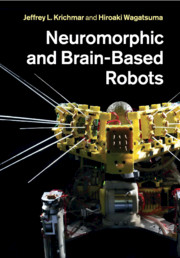Book contents
- Frontmatter
- Contents
- Contributors
- Preface
- Part I Introduction
- Part II Neuromorphic robots: biologically and neurally inspired designs
- Part III Brain-based robots: architectures and approaches
- 5 The RatSLAM project: robot spatial navigation
- 6 Evolution of rewards and learning mechanisms in Cyber Rodents
- 7 A neuromorphically inspired architecture for cognitive robots
- 8 Autonomous visuomotor development for neuromorphic robots
- 9 Brain-inspired robots for autistic training and care
- Part IV Philosophical and theoretical considerations
- Part V Ethical considerations
- Index
- References
7 - A neuromorphically inspired architecture for cognitive robots
from Part III - Brain-based robots: architectures and approaches
Published online by Cambridge University Press: 05 February 2012
- Frontmatter
- Contents
- Contributors
- Preface
- Part I Introduction
- Part II Neuromorphic robots: biologically and neurally inspired designs
- Part III Brain-based robots: architectures and approaches
- 5 The RatSLAM project: robot spatial navigation
- 6 Evolution of rewards and learning mechanisms in Cyber Rodents
- 7 A neuromorphically inspired architecture for cognitive robots
- 8 Autonomous visuomotor development for neuromorphic robots
- 9 Brain-inspired robots for autistic training and care
- Part IV Philosophical and theoretical considerations
- Part V Ethical considerations
- Index
- References
Summary
Introduction
After several decades of developmental research on intelligent robotics in our lab, we began to focus on the realization of mammalian adaptability functions for our upper-body humanoid robot ISAC (Intelligent Soft Arm Control) described in Kawamura et al. (2000, 2004). Currently, most engineering solutions used in robot designs do not have this level of learning and adaptation. Mammalian adaptability is highly desirable in a robot, because mammals are singularly adaptable goal-directed agents. Mammals learn from experiences with a distinctive degree of flexibility and richness that assures goal accomplishment by a very high proportion of individuals. Thus, in the future, robot capability will be substantially advanced once robots can actively seek goal-directed experiences and learn about new tasks under dynamic and challenging environments.
Seeking inspiration for how to achieve this goal, we look to the mammalian brain; in particular, to the structural and functional commonalities observed across mammalian species. From rodents to humans, mammals share many neural mechanisms and control processes relevant to adaptability. Mammals typically accomplish goals in a timely fashion, in situations from the familiar to the new and challenging. Moreover, mammals learn how to function effectively, with few innate capabilities and with little or no supervision of their learning. Albeit with many gaps in knowledge of what makes the human brain distinctively capable, enough seems to be known about the whole mammalian brain to inform architectural analysis and embodied modeling of mammalian brains.
Information
- Type
- Chapter
- Information
- Neuromorphic and Brain-Based Robots , pp. 129 - 155Publisher: Cambridge University PressPrint publication year: 2011
References
Accessibility standard: Unknown
Why this information is here
This section outlines the accessibility features of this content - including support for screen readers, full keyboard navigation and high-contrast display options. This may not be relevant for you.Accessibility Information
- 1
- Cited by
